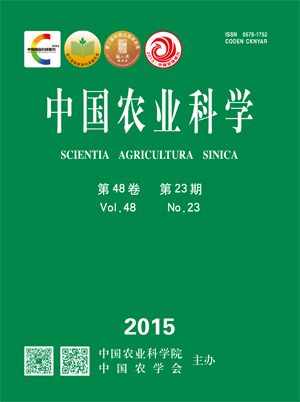-
Effect of Long-Term Organic-Manure Combined with Chemical Fertilizers on Aggregate Sizes Distribution and Its Organic and Inorganic Carbon on a Tier Soil
- WANG Ren-jie, Qiang Jiu Ci-ren, XUE Yan-fei, ZHANG Shu-lan, YANG Xue-yun
-
Scientia Agricultura Sinica. 2015, 48(23):
4678-4689.
doi:10.3864/j.issn.0578-1752.2015.23.009
-
 Abstract
(
576 )
Abstract
(
576 )
 HTML
(
5 )
HTML
(
5 )
 PDF (419KB)
(
359
)
PDF (419KB)
(
359
)
 Save
Save
-
References |
Related Articles |
Metrics
【Objective】The objective of this study is to investigate the effect of long-term application of organic manure combined with chemical fertilizers on distribution of water-stable aggregates and their organic carbon (SOC) and inorganic carbon (SIC) in a tier soil under winter wheat and summer maize rotation system, and to get deep insight into the mechanisms of soil carbon sequestration in tier soil.【Method】 Soil samples with an increment of 10-30 cm were collected from a 21-year long-term field experiment. Collected soil samples of two treatments, of which one receiving no fertilizer (CK) and the other, receiving organic manure plus N, P and K fertilizers (MNPK), were separated into 5 aggregate-sizes classes by wet sieving. And then both organic and inorganic carbon contents in each size of aggregates and bulk soils were determined.【Result】Compared to CK, MNPK significantly reduced the proportion of aggregates that >1 mm at all three soil horizons, while increased the 0.25-1 mm aggregates at 0-20 cm soil layers. MNPK significantly decreased the mean weight diameter (MWD) at 0-10, 10-20 and 20-30 cm soil horizons by 26.6%, 38.3% and 62.4%, respectively. MNPK also decreased the geometric mean diameter (GMD) at 20-30 cm soil depth, but had no effect on it at 0-20 cm soil layers. In comparison to CK, MNPK significantly increased the SOC contents of bulk soils by 150%, 97% and 42%, respectively, for above three soil layers; and enhanced SOC in aggregates >2 mm, 1-2 mm, 0.5-1 mm, 0.25-0.5 mm and <0.25 mm by 163%, 160%, 111%, 86% and 61%, respectively at 0-10 cm; by 97%, 109%, 118%, 39% and 45%, respectively at 10-20 cm soil horizons. Organic carbon concentration of aggregates generally tended to increase with the increasing size of aggregates. MNPK greatly improved the SIC of bulk soils by 28.2% at 20-30 cm soil depth. However, the SIC of the macro-aggregates showed a tendency of decreasing on MNPK over CK at 0-10 cm soil horizons, where it decreased drastically in >2 mm and 0.25-0.5 mm sizes fractions; while it remained unchanged at 10-20 cm soil horizons but enhanced markedly in all sizes of aggregates at 20-30 cm soil depth by 22.1%-36.6%. The results also exhibited that greater than 50% of SOC were sequestrated in aggregate of <0.25 mm sizes fraction, with less than 10% in 1-2 mm sizes fractions. The MNPK treatment considerably lowered the proportions of SOC in aggregates of >2 mm and <0.25 mm over CK, where the proportions of SOC decreased by 4.33% and 13.78%, respectively, at 0-10 cm soil depth, by 10.24% and 7.81%, respectively, at 10-20 cm soil depth; while it significantly enhanced the partitioning proportions of SOC in 0.5-1 and 0.25-0.5 mm fractions over CK by 13.8% and 5.66%, respectively, in 0-10 cm soil depth, by 13.46% and 5.41%, respectively, in 10-20 cm soil depth. MNPK significantly increased proportions of SIC in aggregates of 0.5-1 mm and 0.25-0.5 mm by 9.03%, 4.59%, respectively, at 0-10 cm, and by 9.28%, 6.96%, respectively, at 10-20 cm soil depth. By contrast, MNPK considerably reduced the proportions of SIC in >2 mm aggregates at 0-10 cm and 10-20 cm by 6.95% and 12.53%, respectively. At 20-30 cm soil depth, MNPK substantially increased the proportion of SIC in <0.25 mm aggregates by 18.98%, while reduced them in >2 mm and 1-2 mm aggregates by 16.67% and 5.28%, respectively.【Conclusion】Long-term application of organic manure combined with chemical fertilizers significantly promoted the soil carbon sequestration in the way of changing the distribution of water stable aggregates and the partitioning proportions of soil carbon sequestrated in aggregates of varying sizes on Tier soil. In addition, as an index of soil aggregates stability evaluation, GMD is more suitable than MWD for the investigated soil.









